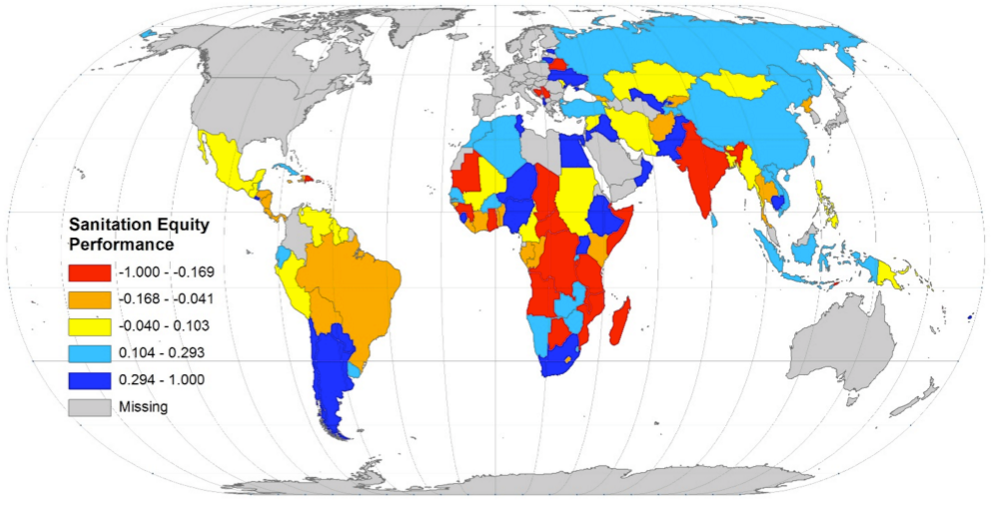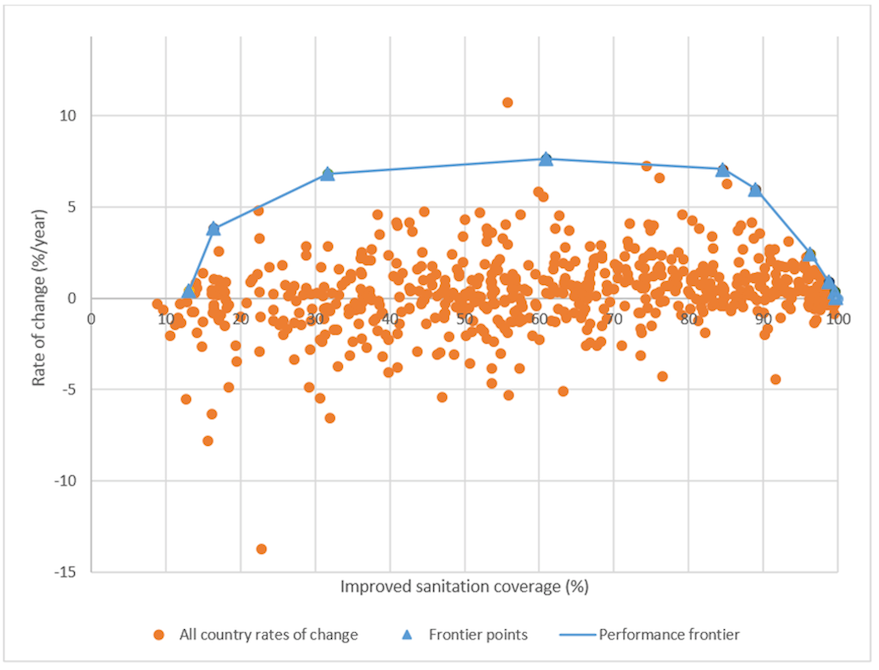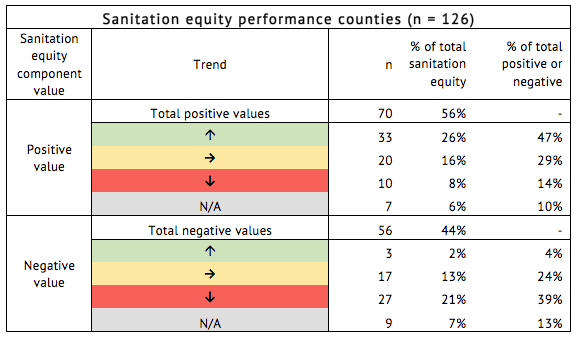The WASH Performance Index Report - Sanitation Equity
Contents
[hide]Country performance in improving sanitation equity
- Country rates of change (progression or regression, percent per year) in equity of access to sanitation were compared to the performance frontier (best-in-class performance) to generate a country value for performance in improving sanitation equity. For the 2015 Index we used the gap in rural and urban coverage as our indicator of equity.
- Country performance in improving sanitation equity was significantly positively associated with governance indicators including control of corruption, government effectiveness, regulatory quality, and rule of law. This suggests governance may be an underlying driver of country performance in improving sanitation equity.
- Country performance in improving sanitation equity was significantly positively associated with the Middle East and North Africa region, suggesting countries from this region have better performance.
- Top performing countries are Egypt, Niger, Estonia, Jordan, Ukraine, South Africa, Chile, Pakistan, Fiji, and Uzbekistan.
- Bottom performing countries are Vanuatu, Botswana, Mauritania, Samoa, India, Belarus, Central African Republic, Burundi, Timor-Leste, and Tanzania.
Country rates of change (progression or regression, percent per year) in equity of access to sanitation were compared to the performance frontier (best-in-class performance) to generate a country value for performance in improving sanitation equity. For the 2015 Index we used the gap in rural and urban coverage as our indicator of equity. Values for sanitation equity performance were calculated for 126 countries. Figure 16 summarizes the values.

Figure 17 shows all the rates of change used in defining the performance frontier for sanitation equity which is also shown. Points defining the performance frontier were: Niger (2007), Malawi (2008), India (2000), Paraguay (1999), South Africa (2008), Mexico (2002), Bosnia and Herzegovina (2001), Egypt (2006), Estonia (2011), and Estonia (2009). Figure 18 only shows the latest rates of change from each country.


Top and bottom performing countries
Top performing countries for sanitation equity performance are Egypt, Niger, Estonia, Jordan, Ukraine, South Africa, Chile, Pakistan, Fiji, Uzbekistan, and Palau. Bottom performing countries are Vanuatu, Botswana, Mauritania, Samoa, India, Belarus, Central African Republic, Burundi, Timor-Leste, and Tanzania. Among the most populated countries in the world, Pakistan, Nigeria, and Indonesia were among top performers while the Philippines, Brazil, and India were among the bottom performers.
Although India defined the performance frontier in 2000 (suggesting best-in-class performance), their most recent performance indicates that they are a bottom performing country despite the recent launch of the “Clean India Mission” by Prime Minister Modi. This demonstrates that performance can vary over time.
Alphabetical lists of countries with values for all components and trends are available in the Annex.
Correlations
Country performance in improving sanitation equity is associated with control of corruption, government effectiveness, regulatory quality, and rule of law. These results highlight the importance of governance and its role in establishing an enabling environment, and their contribution to progress in sanitation equity.
In terms of country characteristics, performance is positively associated with both GDP and GNI per capita and strongly negatively correlated with income group. Sanitation equity performance is significantly higher in the Middle East and North Africa region as compared to other regions. It is also significantly associated with countries that have a larger urban population.
Trends in performance
Table 5 shows the trend in country values for sanitation equity performance. The trends suggest countries with a positive value are more likely to be increasing over time (47%) rather than deteriorating. Conversely, 39% of countries with a negative value deteriorated over time rather than improving. This suggests improvement and deterioration are long-term phenomena.

Acknowledgements
- The WASH Performance Index Report, The Water Institute - University of North Carolina.

